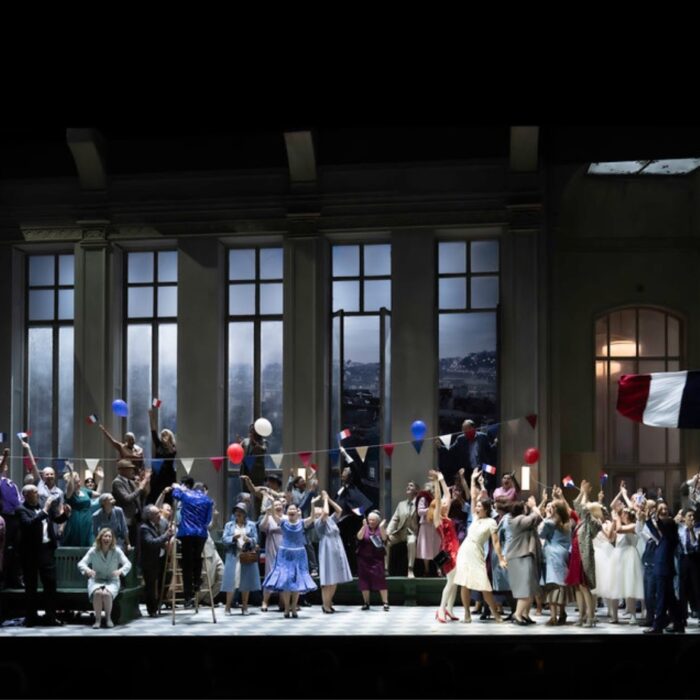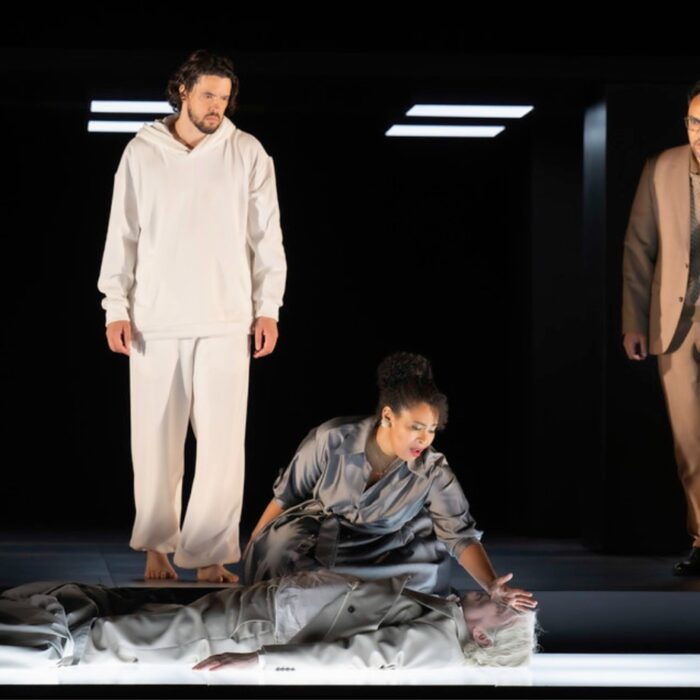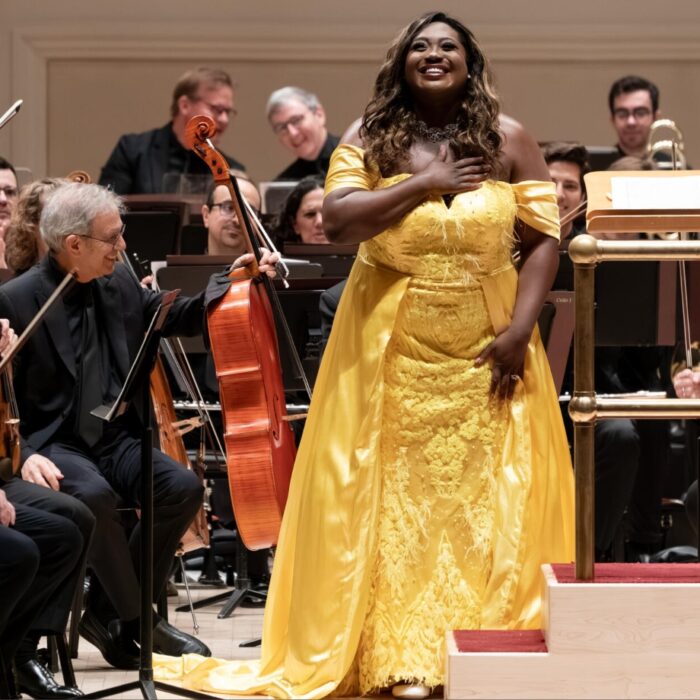
Opéra National de Paris 2022-23 Review: La Bohème
Ailyn Pérez & Gianluca Buratto Power Through Depressing but Unforgettable Puccini Staging
By João Marcos Copertino(Photo Credit: @Guergana Damianova – OnP)
When Claus Guth’s spatial version of “La Bohème” opened in 2017, the Opéra Bastille shook with all the insults it received. Puccini’s opera is often understood as an artefact, and productions will flirt with disaster if they do not depict a snow-globe Paris, crystallized in everyone’s mind. Guth did not abandon a visually beautiful representation but clearly left Paris behind. Now time has passed, and it seems that those who came to see the infamous space opera were satisfied with what they saw. There was no insults.
The issue, however, is that Bastille’s parterre has never been so empty.
Puccini Meets Tarkovsky
For those unacquainted with Guth’s Space Odyssey: it is “La Bohème” meets “Solaris.” Four surviving astronauts are in a “sinking” spaceship. Oxygen is low, and you can see the body of a dead astronaut. At first, to pass time, they start to improvise around the plot of the opera and even use the deceased body as Benoît, the pathetic landlord. Progressively, what was a joke starts to be a real hallucination when Rodolfo has a vision of the beautiful Mimì. Then he realizes that he is skirting insanity, and his illusions only escalate. Guth wisely uses doppelgangers to stress how the illusion materializes to Rodolfo’s eyes. Eventually, they all reach a foreign planet—or asteroid—and they all die.
The idea of Mimì as an illusion of Rodolfo’s mind is not entirely new. It was Wayne Kostenbaum who once stressed that “Mimì” is also a reference to the first-person reflexive pronoun in Italian. She herself says they often call her “Mimì,” but her name is actually Lucia. Although Mimì/Lucia does not know why they gave her such nickname, Kostenbaum knows—and Guth seems to agree—: she is a projection of Rodolfo, but she also represents his “self” in face of the loss of his life/youth.
Guth’s staging effectively scaffolds the macabre and sorrowful in “Bohème.” The illusion is essential, as a coping mechanism to deal with harshness of life. To realize such a brutal truth changes how one listens to the music in “La Bohème:” Puccini’s orchestra, often overshadowed by the beautiful vocal lines, is elevated and given an ethereal aura.
And even the flintiest pharaoh’s heart cannot deny the beauty at the end of this production of the opera as all the astronauts lie dead on an incognito planet. No cheap sentimentalism is deployed, just the ineffable composition of deciduous life in the face of the giant, eternal, and uncaring universe.
But one cannot leave the production without being ambivalent. It is an impressive production, but does one want to see it more than once or twice in a lifetime? Puccini’s idealistic construction of cities—be it his Rome, Paris or even Beijing—each time tells a story through the composer’s soundscape that makes all but imperative those stage extravaganzas à la Franco Zeffirelli. Part of the life of the opera relies precisely on the grandiloquence of the space surrounding it. And the whole of sidereal space might not be as magical as Paris.
Sound in a Vaccuum
Bastille’s acoustics and Etienne Pluss’s scenarios are the living proof that no sound carries in a vacuum. Most singers—the exceptions will be noted—struggled to be heard, and the decision to put the second act’s chorus off-stage led to poorly synchronized scene.
American soprano Ailyn Pérez was a lyrical and ideal Mimì. Some sopranos sing with the same tonus as Tosca and Aida; not Pérez. She truly inhabits the idea of Mimì as a spectral idealization of a man’s mind. Her voice is pure, with no exaggerated vibrato or operatic affectation. When Mimì mimics Rodolfo’s “Che Gelida Manina,” Peréz sings with a childlike purity. But be aware, however, that Mimì’s illusions here are the pathway to death.
Tenor Joshua Guerrero struggled to make his voice heard. His final “Mimì” was so inaudible that was anticlimactic. Occasionally, his consonants were also compromised, especially the “r’s” and “m’s.” Do not get me wrong, Guerrero does have a vocal color that suits Puccini’s music well. His voice, marked by an expressive use of the vocal passage, has a dramatism and virility that is pleasing. Moreover, his phrasing—when audible—is well-intended and always interesting, although some of his pianissimos had a shaky intonation. But on this occasion, the beauty of his singing was lost in space.
Slávka Zámečníková sings a proper Musetta, but her characterization misses the humor, audacity, and charisma of the role. But it is not her fault. The staging is depressing (everyone will die), and Musetta’s status as an illusion is way less feasible than Mimì’s. In her big scene (“Quando m’en vo’”), conductor Michele Mariotti expanded some fermatas more than he should have, destabilizing the waltzing tempo of the aria. She was also forced to sing many of her lines off-stage—even in the final act.
A similar issue plagued Andrzej Filończyk (Marcello) and—to a minor degree—Simone de Salvio (Schaunard). Although they are singers with beautiful tones, the staging caused their participation to fade away, removing any possible charisma from their characters. Marcello’s cockiness in the third act, for example, is so out of place that it makes no sense. Thankfully, the four poor sidereAilal residents of Quartier Latin do work well, musically, in the fourth-act quartets. However, it is hard to laugh when one can see the dead bodies of the characters lying on the stage.
Gianluca Buratto was the only male singer that did not struggle at all with projecting his voice. His “Vecchia zimarra” was nothing short of exuberant. Singing without seeking any sentimentalism, Buratto deployed a slower tempo than usual, frizzing his legato. More than a short philosophical reflection, the aria was the perfect farewell to life.
The cast was completed by Franck Leguérinel, Luca Sannai, Bernard Arrieta, Pierpaolo Palloni, Paolo Bondi, and Virgilie Chorlet.
Conductor Michele Mariotti had a heterodox take on Puccini’s score that seemed to be well-received by the public, which gave it their warmest applause. The sidereal aspect of the staging affected his reading of the music, causing him to avoid the most dramatic tonalities of the score— as such, the opera finale was the most distorted. His tempi were slow, and his fermatas were long. To find some new sound in “La Bohème” is a merit in itself.
However, Mariotti committed the unredeemable sin of opera: he did follow the singers. The construction of his ethereal blank orchestral sound, he often covered singers’ voices and prevented them from showcasing their own musical phrases.
So, ultimately, this was an unforgettable, unsentimental “La Bohème” in space. It is an interesting experience with some good singing from Pérez and, especially, from Buratto. If one is not super attached to more conventional forms of staging Puccini, one can even be more entertained than confused when watching it.
Nonetheless, when I returned home, I searched compulsively for other recordings of “La Bohème”—from Toscanini to Armiliato; Björling and De Los Angeles to Gheorghiu and Vargas—and they all sounded better than this sidereal “Bohème.”


